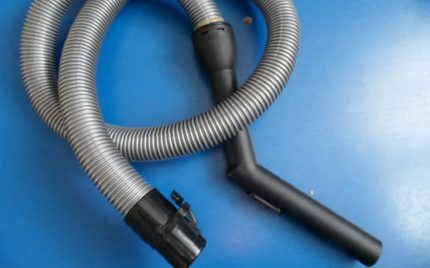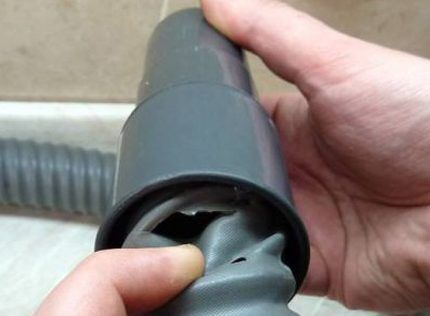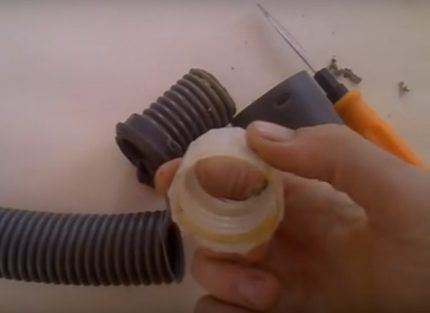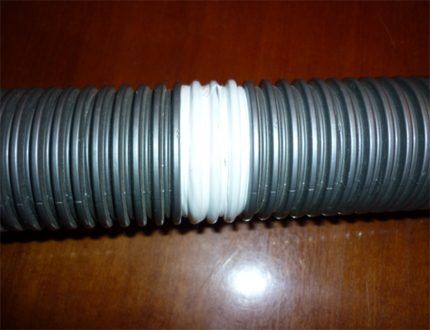How to fix a vacuum cleaner hose: causes of damage + DIY repair methods
A significant proportion of household vacuum cleaners in use are designs that use a flexible corrugated hose. When cleaning a room, it is exposed to loads of various types, which does not exclude the possibility of damage to this part of the vacuum cleaner, right?
Have you had a similar problem, but you don’t know how to fix a vacuum cleaner hose with your own hands? We will help you deal with this problem.
The article discusses the most likely causes of a corrugated hose defect, and also provides detailed instructions for restoring the integrity of the part. The methods we propose to fix problems are quite simple, so any home craftsman can carry out the repairs.
The content of the article:
Hose design features
Most corrugated hoses for cleaning equipment are a tube made of elastic material (polypropylene).
The tube is usually no more than 1.5 meters long. Thanks to the corrugated surface, the accessory has the ability to stretch within small limits.

One end of the flexible conduit ends in a short piece of rigid plastic tubing. This part is a connection link with the extension rod or directly with the working nozzle of the vacuum cleaner.
The opposite end of the hose is equipped with a short locking pipe, through which a locking connection is formed with the vacuum cleaner module. This lock pipe is actually also a continuation of the corrugated tube.

The practice of using vacuum cleaners notes that it is along the lines of junction of the elastic corrugation with the end rigid elements that rupture most often occurs, and hose breakage is considered one of the most common vacuum cleaner breakdowns.
Meanwhile, the formation of even a small rupture in the hose leads to a significant loss of efficiency of harvesting equipment.
Causes of defects
Cracks, tears, and punctures on the body of the vacuum cleaner hose can appear for various reasons. However, the main reason, of course, should be considered improper handling of this part.
What user actions lead to the appearance of defects on the body of the corrugated tube?
Take a closer look:
- Towing a vacuum cleaner from place to place via a hose.
- The tube is bent at unacceptable angles during the cleaning process.
- Inaccurate use when cleaning objects with sharp edges.
- Storage not according to instructions.
The natural cause of the formation of defects should also be considered the expiration of the product’s service life, wear, and poor quality of the material.

Towing a vacuum cleaner from place to place by pulling the device by the working hose is a fairly common practice.
At the same time, many owners of vacuum cleaners perform such “tricks” completely unaware of the impending consequences. Meanwhile, the instructions for any vacuum cleaner clearly state that you cannot do this!
Bending of the pipeline at an unacceptable angle can occur when the owner of a vacuum cleaner, in the heat of cleaning, seeks to reach areas that are theoretically inaccessible due to the operational and technical parameters of the cleaning equipment.

Several times such attempts can end quite successfully. However, the strength of the material with respect to unacceptable loads is not unlimited. Therefore, at the most inopportune moment, the pipeline will simply burst in the place where there was an unacceptable bend.
Cleaning work can be carried out under different conditions. For example, when cleaning furniture whose frame has metal parts with sharp edges. If the hose is handled carelessly under such conditions, there are all the prerequisites for cuts to appear on the body of the corrugation.
Finally, the rules for storing cleaning equipment, specifically described in the vacuum cleaner instructions, also cannot be violated, since violation here is one of the reasons for the malfunction of the vacuum cleaner hose.

Thus, storing the device together with accessories, or separately accessories, at a temperature below the recommended one leads to a decrease in the strength of the corrugated tube material.
Sudden temperature changes, loaded conditions, and unacceptable bends are also critical for the hose material.
DIY repair instructions
If the flexible hose of a vacuum cleaner is damaged, this is not a reason to make a decision regarding changing household appliances.
As user experience shows, it is quite easy to restore a defective corrugated vacuum cleaner hose to normal working condition. And it’s quite easy to do it yourself. Let's consider the options.
Option #1 - repair with a simple cut
Most often, gusts form at the junction of the flexible hose with hard plastic end pipes.
It does not matter in which part the rupture occurred - at the point of connection of the tube under the rod or at the point of connection of the pipe-lock. The repair principle is the same in both cases.

For repairs in such cases, the only tool required is a sharp knife.
Work progress:
- Make an even cut of the hose slightly away from the gust.
- Carefully remove the residual corrugation material from the inside of the end cap.
- Treat the cleaned interior area with sealant.
- Carefully screw the end cap onto the cut end of the hose.
As a rule, the end plastic parts have a screw landing track inside.
Therefore, the evenly cut part of the corrugation is screwed well into the inner area of the end cap, and by coating the “thread” with sealant, the connection is sealed and quite strong.

Many modern vacuum cleaners, e.g. companies Samsung, are equipped with hoses with collapsible ends. Inside of which sits a nylon bushing with a thread into which the end of the hose is screwed. The nylon bushing is secured inside the end switch pipe with an annular plug with clamps.
The principle of repairing such assemblies is similar. You only need to release the clamps, remove the ring plug and the nylon bushing with the torn piece of hose.
Then remove the torn part from the bushing, cut the hose, screw a nylon bushing onto the cut end and assemble everything in the reverse order.
Option #2 - using the overlay bandage method
Defects of this kind usually appear as a result of damage from mechanical hard objects and often through the fault of the owner of the equipment. Moreover, the damage may take the form of cuts, tears, or punctures.

Here, a rather practical and effective way to restore the functionality of the corrugated hose of a vacuum cleaner is to use a piece of a bicycle rubber inner tube as a repair material.
Repair instructions:
- Exactly (perpendicularly) cut out the damaged corrugation segment.
- Clean (degrease) the ends of the cuts well.
- Take a solid piece of a bicycle tube 80-100 mm long.
- Place a piece of the camera on any of the corrugated sections and stretch it a little further than the cut point.
- Apply Moment type glue to the ends of the cuts and connect the hose sections.
- Treat the surface of the corrugation in the joint area with universal glue.
- Pull a piece of the chamber in the opposite direction along the hose until the rubber completely covers the connection point.
The rubber of a bicycle tube has good stretching properties, so pulling it through the hose is not difficult.
At the same time, the slightly smaller diameter of the chamber allows for a fairly tight fit of the hose corrugation at the connection point. The applied adhesive enhances the tensile strength.
In this way, a neat connection is obtained that does not actually violate the elastic properties of the corrugation.
Option #3 - using the thermal method
There is another technique, more complex than the methods noted above, but the quality result can be obtained at the level of factory execution. We are talking about a thermal method for restoring a defective vacuum cleaner hose using a heat-shrink tube and a hair dryer.

It should be noted: in this option there is no need to cut (shorten) the hose, which has its advantages.
The work instructions are as follows:
- Select the heat shrink tube according to the color and corrugation diameter size.
- Disassemble and dismantle the end switch on the entire part of the hose.
- Place a heat-shrinkable tube through the freed end and stretch it to the point of the break.
- Cover the damaged area with heat-shrink tubing with a margin of a few centimeters on both edges.
- Use a hair dryer to heat the heat shrink, gradually moving the tool along the entire length of the patch.
This method is also good for repairing punctures and cracks in any part of the corrugated pipe.
Another question is that a hair dryer or similar tool is a rather specific technique and may not always be at hand.
Option #4 - repair of corrugation with internal conductors
Another task that is quite complex from a technical point of view is the repair of a vacuum cleaner hose, the design of which contains an electrical switching line.
A similar system is usually used on accessories complemented by a handle with an airflow control panel, for example, Samsung SC6573.

The difficulty of repair lies in the fact that to eliminate the break, it is necessary to cut off the defective piece, and along with it, it is inevitably necessary to cut the commutating line, consisting of two conductors. The cut wire is subsequently re-soldered onto the working contacts.
If you are the owner of a Samsung vacuum cleaner, we recommend that you familiarize yourself with the information about typical breakdowns of equipment from this brand, which is presented in this article.
The instructions in this case are as follows:
- Disassemble the housing of the lock pipe.
- Unscrew the pipe from the hose counterclockwise.
- Cut off the defective part, taking into account the sufficient length of the wires.
- Resolder the contact pins onto the conductors.
- Assemble the housing of the lock pipe.
Bursts on such systems can also appear on the opposite side, at the junction of the hose with the control handle. There may also be a defect only in the breakage of the wires without destruction of the hose.
In this state of affairs, repairs become even more complicated, since we have to solve the problem of restoring the functionality of the contact mechanism of the communication line.
Option #5 - temporary recovery technique
Quite often, vacuum cleaner owners resort to the simplest methods of repairing a hose when a rupture, puncture or crack occurs. To carry out repairs, adhesive tape, insulating tape or plumber's tape are usually used.

In principle, these temporary measures taken during operation until the corrugation is replaced with a new one are acceptable, but from the point of view of continuing the efficient operation of the equipment, this is not the best option.
If you still decide to use one of the simple methods, in any case it is recommended to follow the standard instructions:
- The area where the tape or adhesive tape is applied must be cleaned.
- It is advisable to degrease the area to be repaired using suitable products.
- Apply the tape tightly and evenly according to the “turn upon turn” principle in at least two layers.
- It is advisable to secure the end of the tape with glue.
If these instructions are followed, the temporary patch at the leak site can serve for quite a long time. But this does not change the “temporary” status.
Conclusions and useful video on the topic
In the video below, the technician will demonstrate how to repair a hose containing a communication line inside:
Repairing a vacuum cleaner hose often does not cause any particular difficulties for the user. The main criteria for making independent hose repairs are the ability to hold a plumbing tool in your hands and, accordingly, a creative impulse to carry out repair work. Without both, the quality of the repair is not guaranteed.
Do you have anything to add or have questions about repairing a flexible corrugated hose? You can leave comments on the publication, participate in discussions and share your own experience of fixing this part of the vacuum cleaner. The contact form is located in the lower block.




A hose from a vacuum cleaner is something that you can actually repair yourself. I personally have already repaired a couple of hoses from different vacuum cleaners. The first case is simple - the corrugated hose has torn almost at the entrance to the handle. I shortened it and, for reliability, applied glue under the coupling. But this method was not suitable for the second situation, when the hose frayed at the bend almost in the center. There I simply cut out a tube from an old bicycle inner tube, pulled it onto a hose and wrapped it with electrical tape on top. It doesn't look very aesthetically pleasing, but the main thing is that it works.
In our old vacuum cleaner, the hose broke at the junction with the end pipe.Initially, the hose fell out; it had to be constantly pushed back and held by hand so that it did not fall out. Afterwards, the father-in-law glued the hose to the pipe using tape, but this also did not work, since tape has poor adhesive ability. As a result, we glued the hose with sealant, and then we began vacuuming without problems.
In general, the methods presented here are more like temporary ones. No matter how well you seal the gap, it will still not become as airtight as it was. It's easier to buy a new hose. Although if it is torn at the joint, then you can really cut off the excess.